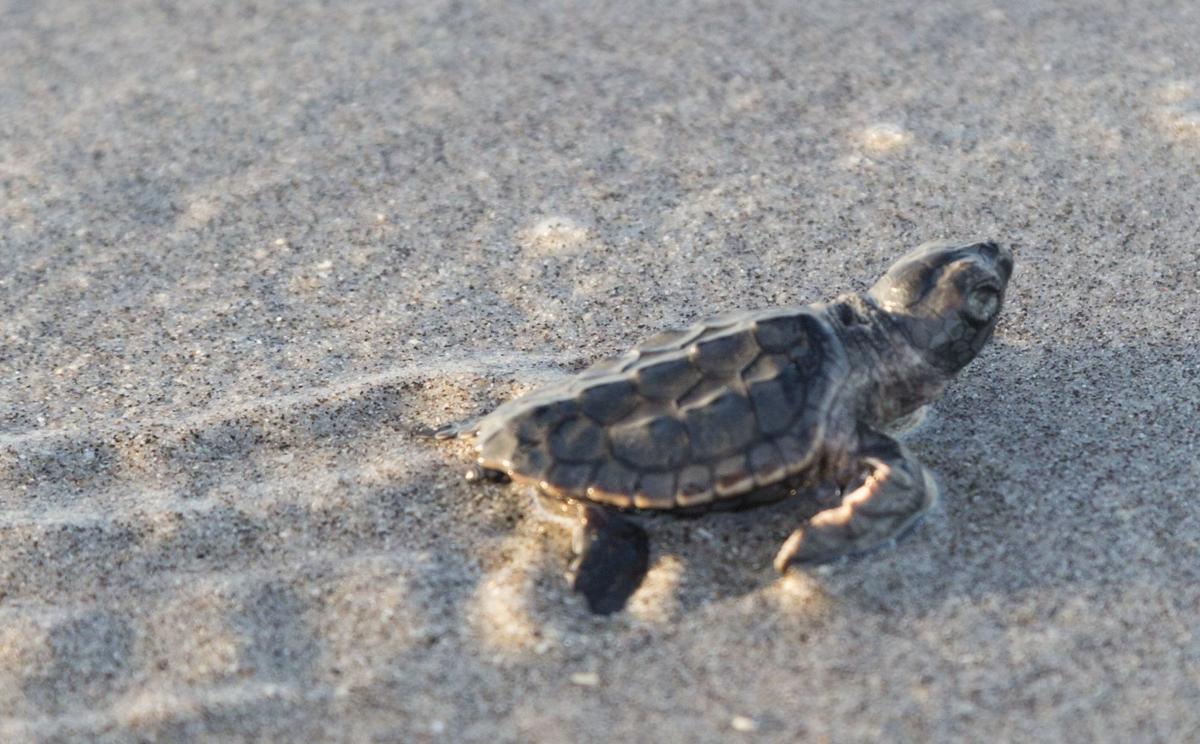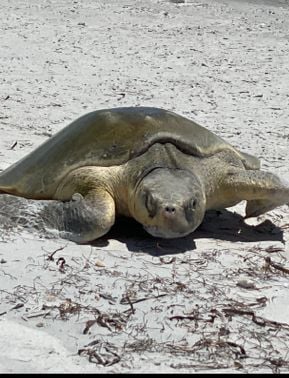

A loggerhead hatchling, newly emerged from its nest, heads to the Gulf where it will begin its life journey.
Photos provided by Mary Lundberg
ENGLEWOOD — On a good year, Brenda Bossman might expect loggerheads to lay 100 or 125 eggs in a nest.
This season, Bossman, who tracks nesting on Don Pedro and Knight Islands, has discovered nests with 144 eggs and another with 149 eggs. So far this season, volunteer sea turtle patrols on those barrier islands off the coast near Englewood counted 250 or more loggerhead nests and 20 green sea turtle nests.
The recent renourishing of eroding shorelines of Manasota Key, Don Pedro and Knight islands hasn't dissuaded the sea turtles from nesting.
Two weeks ago, Charlotte County Natural Resources project manager Jamie Scudera told the Beaches and Shores Advisory Committee how the county's barrier islands were enjoying a bountiful nesting season.
The Coastal Wildlife Club — which oversees nesting on Manasota Key — agrees.
"The only year with higher number at this time was 2016," CWC board member Carol Leonard said.
As of Friday, CWC patrols identified 3,728 loggerhead nests, 72 green and two Kemp's ridley sea turtle nests on Manasota Key. Kemp's ridley are the smallest and most endangered sea turtle species.
Mote Marine Laboratory oversees volunteer sea turtle patrols from Venice north to Longboat Key.
As of July 4, Mote reported 2,803 loggerhead nests and 40 green sea turtle nests. Casey Key is seeing the most nests — 170 loggerhead and nine green sea turtle nests.
Predators and people
Coyotes are preying upon nests on the north end of Knight and Don Pedro islands. Armadillos are preying, more so than the coyotes, upon nests on the south end of the islands, Bossman said.
But people can pose an even greater danger to sea turtles, especially for the hatchlings emerging from their nests and making a mad scramble to the Gulf.
"Nests have begun to hatch, so now is the time to be especially cautious of any lights visible from the nesting beaches," Leonard said. "Ideally at night, sea turtles would have dark, quiet beaches all to themselves."
Artificial light is especially disorientating to the nesting turtles and their hatchlings emerging from their nests. Instincts tell them to head for the Gulf and the lighted horizon, but artificial light can lead them to head into the opposite direction.
"While red is the least disruptive color for sea turtles, red is seen by the turtles and they can find it disturbing enough to abandon their attempt to nest," Leonard said. "Many red flashlights are actually white lights with red coverings that actually allow other wavelengths through. LED lights emit limited wavelengths (colors) but are often much brighter."
"Flashlight beams narrow your field of vision," said Leonard, who is a retired Lemon Bay High School science teacher. "Letting your eyes adjust to the darkness allows you to observe more of the beach."
She recommends people reserve using flashlights or phone lights for their personal safety, such as on stairs. Hold the light in one hand and shield it with the other, directing the light downward, so that the light is least visible.
"Leave any headband lights at home," Leonard said.
To learn more about sea turtles and nesting, visit myfwc.com.
Ali H. Johnston, MBA in Real Estate
REALTOR®, Lic. Broker #BK3284964
West Villages Realty LLC
19503 S West Villages Pkwy
Stes A2 (by Appt)
Venice, Florida 34293
Office: 941-460-3179



No comments:
Post a Comment